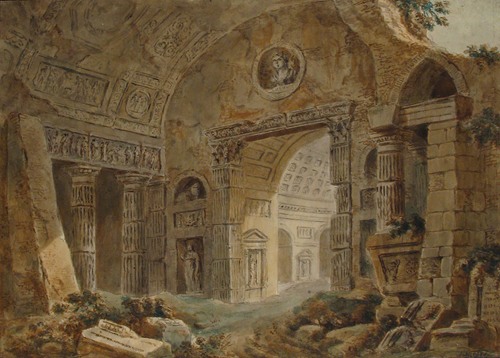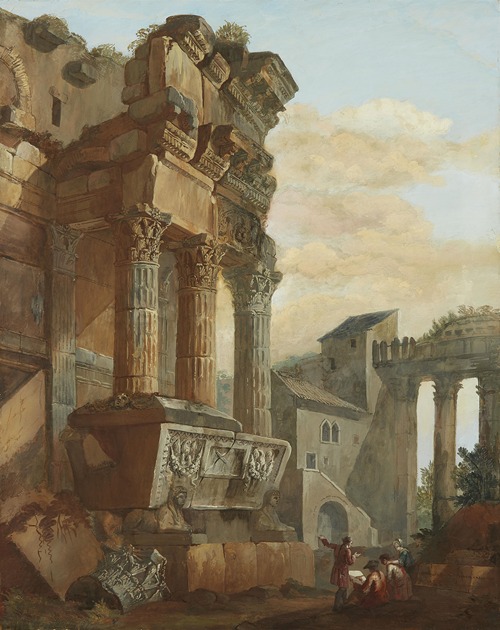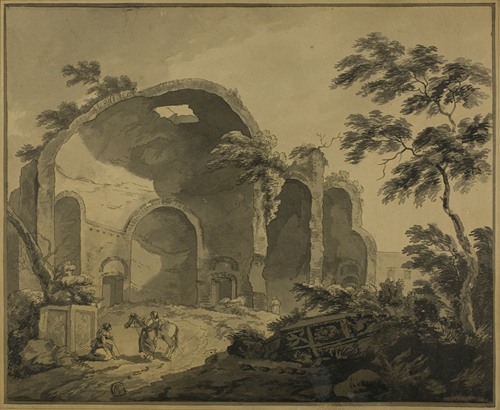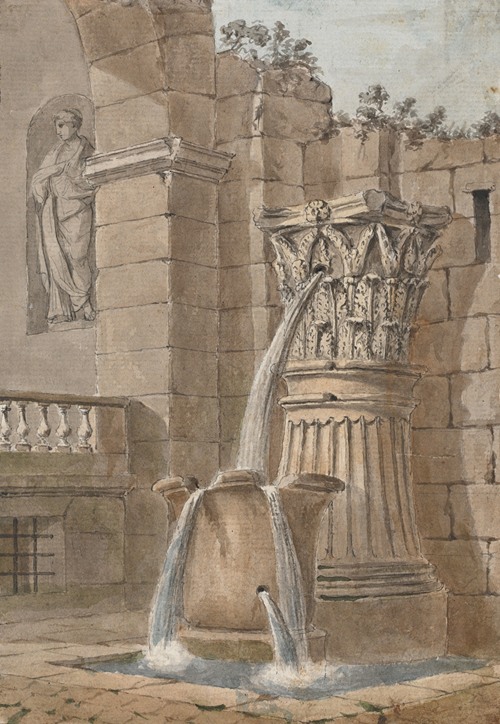
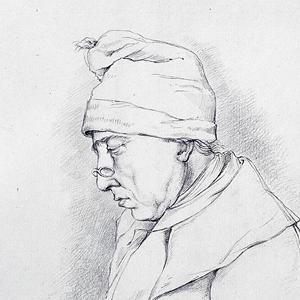
Charles-Louis Clérisseau was a French architect, draughtsman, antiquary, and artist who became a leading authority on ancient Roman architecture and Roman ruins in Italy and France. With his influence extending to Russia, England, and the United States, and clients including Catherine the Great and Thomas Jefferson, Clérisseau played a key role in the genesis of neoclassical architecture during the second half of the 18th century.
Born in Paris, Clérisseau was a pupil of the architect Germain Boffrand. In 1746, in his mid-twenties, he won a Premier Prix de Rome in the architectural competition to design Un grand hôtel, or great mansion.
The prize included a scholarship to study in Rome, and in 1749 Clérisseau became an official pensionnaire (resident) at the French Academy in Rome, where his instructors included the painter of ruins Giovanni Paolo Pannini. In Rome he also befriended Giovanni Battista Piranesi and Claude-Joseph Vernet, and in 1752 the three of them set out on a sketching tour of Hadrian's Villa at Tivoli. Before beginning to draw, the three first had to cut and burn away the undergrowth, where lurked colonies of venomous snakes and scorpions.
In 1753, Clérisseau's final months at the Academy were marred by a bitter dispute with its director, Charles-Joseph Natoire. Clérisseau was for a time expelled, but was eventually allowed to return and complete his scholarship.
In 1755 the Scottish architect Robert Adam arrived in Florence, where he met Clérisseau, who accompanied him to Rome; there the ambitious Adam resolved, under thea of Clérisseau, to produce a volume for publication upon his return to Britain that would establish him as a serious architect. The project finally selected was a volume documenting the ruins of Diocletian's Palace at Split, on the Dalmatian coast. Over a period of five weeks in 1757 Adam sketched and supervised the documentation of the ruins, while Clérisseau produced perspectives, and two German draftsmen undertook the measured drawings. Most of the published engravings in Adam's Ruins of the Palace of the Emperor Diocletian at Spalatro (1764) are believed to be the work of Clérisseau, though he received no credit.
Clérisseau passed most of the next decades in Rome. As it had done since the High Renaissance, ancient Rome and modern Rome functioned as a cultural hub, the ruins of Classical Antiquity providing a school in themselves, if one had a knowledgeable guide. Clérisseau served as a mentor to a generation of young architectural students who (like Clérisseau) had won the prestigious Prix de Rome and came to study at the French Academy in Rome. He also guided the developing taste for the Antique in young French and British artists and gentlemen amateurs on the Grand Tour. His skillful drawings of ancient architectural details, of real Roman ruins and imaginary ones, helped form the taste of young architects like Robert Adam in the 1750s and his brother James Adam, in 1760-63. Clérisseau added to his income by providing architectural illustrations, sometimes in series, for young men on the Grand Tour.
On the first of December, 1763, in San Luigi dei Francesi (Church of St. Louis of the French) in Rome, Clérisseau married Therèse, daughter of the sculptor Pierre de l'Estache. "Clérisseau was forty-two and Therése was presumably much younger, though her father was about seventy-five at the time."
Upon his return to Paris in the summer of 1767, Clérisseau became a magnet for young neoclassical architects, like François-Joseph Bélanger, who themselves never visited Rome.
Although they never met, and he never traveled to Russia, Clérisseau nonetheless attracted the attention of Catherine the Great, who in 1773 solicited from him plans for a house in a style à l'antique to be erected in her gardens at Tsarskoye Selo. Catherine was vexed when she received the plans, which were far more elaborate than she expected, "a grandiose Roman palace" described "as the Baths of Caracalla set into Hadrian's Villa." There is no evidence that Clérisseau was ever paid for the rejected plans. Nevertheless, in 1778 Catherine again approached him, through an emissary, and arranged to purchase over a thousand drawings and artworks from him; this huge cache would ultimately find a home in the Hermitage. In 1780 she asked Clérisseau to design a triumphal arch to be built in Russia, but when the plans arrived she decided the gigantic project would be too large and expensive and abandoned it.
Although his projects for Catherine never came to fruition, Clérisseau's drawings and designs were highly influential in the decoration of her apartments at Tsarskoye Selo. In recognition of his artistic achievements and his efforts on her behalf, the empress made Clérisseau an honorary member of the Imperial Academy of Arts and bestowed on him the title Premier Architecte de Sa Majestée Impériale.
For the Hôtel Grimod de La Reynière, built in Paris in 1775, Clérisseau and Étienne de La Vallée Poussin executed the first decorative scheme in Europe to be inspired by the recent archaeological discoveries at Pompeii and Herculanum. A set of eight painted boiseries depicting sixteen scenes from the life of Achilles were sold in 1850 and are now in the collection of the Victoria and Albert Museum in London.
In 1785, Clérisseau was retained by Thomas Jefferson to produce designs for the Virginia State Capitol, based on the Maison Carrée, the ancient Roman temple in Nîmes. At the time, Jefferson was residing in Paris, serving as American Minister to France. Jefferson wrote that "it was a considerable time before I could find an architect whose taste had been formed on a study of ancient models of this art; the style of architecture in this capital [Paris] being far from chaste." Clérisseau, he noted, "has studied 20 years in Rome, and has given proofs of his skill and taste by a publication of some antiquities of this country." Jefferson was referring to the first (and only) volume in Clérisseau's intended series Antiquités de la France, published in Paris in 1788 with the subtitle Monumens de Nismes. The folio included detailed engravings of the Maison Carrée, which Jefferson praised as "one of the most beautiful, if not the most beautiful and precious morsel of architecture left us by antiquity."
"Clérisseau's role in designing the Capitol has been much debated. Fiske Kimball argues persuasively that the building is essentially Jefferson's and that Clérisseau was merely a consultant."
